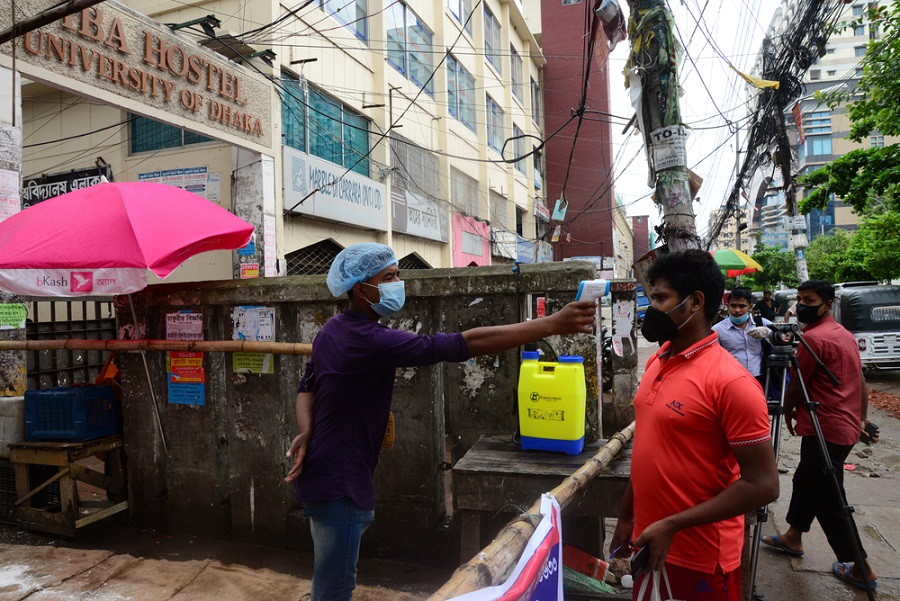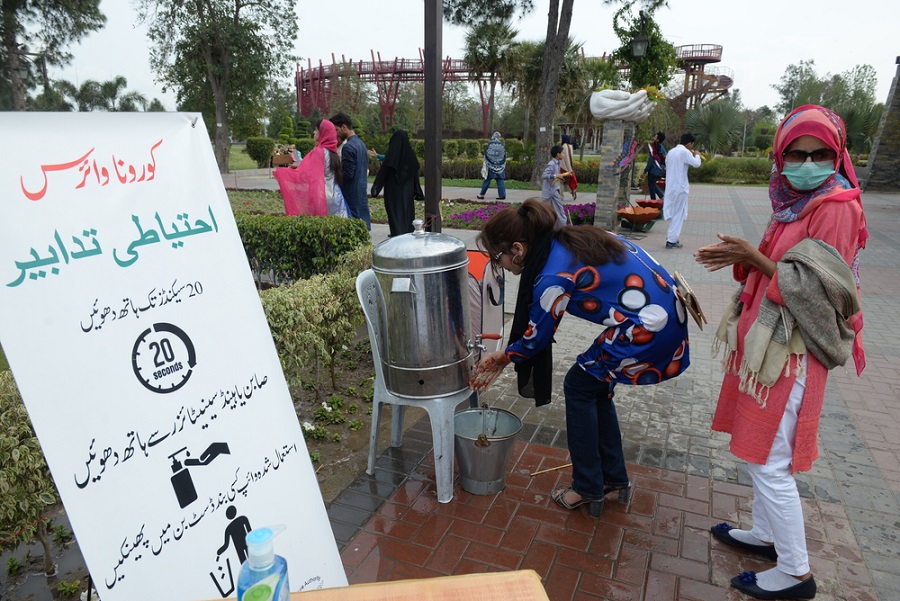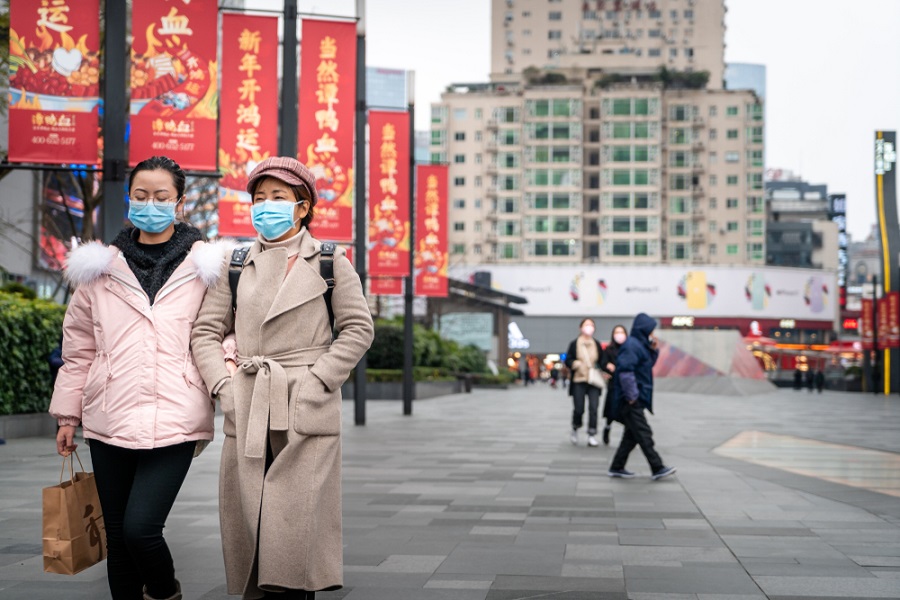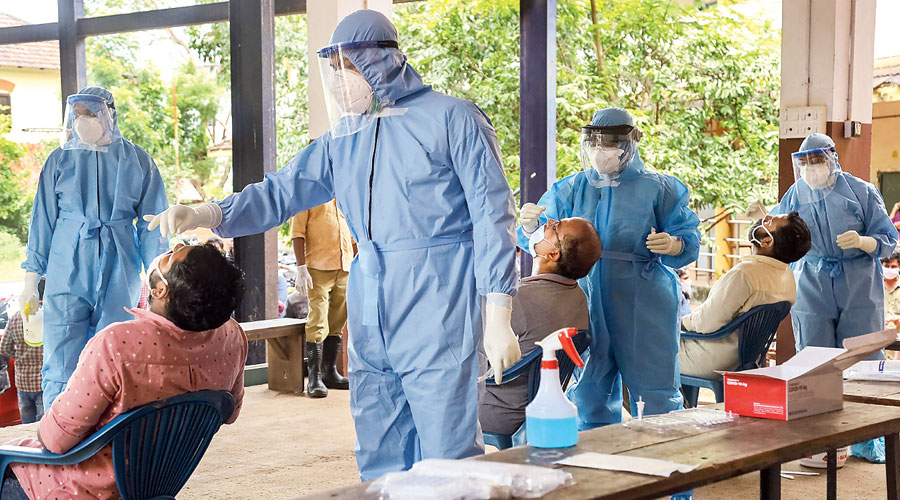The Chinese don’t pull any punches when crushing Covid-19. When distant Kashgar, capital of Xinjiang province, was hit by a handful of Covid-19 cases in late October, authorities flew in hundreds of health workers and built temporary labs to test the city’s entire 4.9 million people in just five days. Now, a few days later, it looks like Mission Accomplished and the threat of a wider Covid-19 outbreak has been averted.
Cross the South China Sea to Vietnam where Covid-19 has been eliminated out differently but with equal efficiency. Within days of China revealing its first Covid case last December, it launched a media blitz, employing TV ads, blanket phone texts, billboards and loudspeakers, exhorting citizens to track, trace and isolate cases. On October 29, Vietnam, which has 96 million people, reported four new cases –all travellers returning from abroad. Before that, it had gone 59 days without a single new Covid case.
Travel the length and breadth of Asia and India stands out – as the one country well and truly felled by Covid-19. We’ve just marked an unhappy milestone by crossing the 8-million infection mark. We’ve been saved from the global number-one spot because Donald Trump’s catastrophic response to Covid means the US has scaled new heights even more swiftly.
What went wrong here? That’s tough to pinpoint but unlike countries like China, Vietnam and South Korea, India had no experience dealing with pandemics like SARS (the only exception being Kerala which had the Nipah epidemic). The test-trace-isolate mantra wasn’t grasped fast enough. Also, Indian hospitals had never had reason to use their RT-PCR testing machines, the gold testing standard, and hadn’t received the training on how to use them – 250 machines are, in fact, in medical research institutions.
It was only July 17 – almost three months after the lockdown had begun -- that the government’s top bureaucrat, cabinet secretary Rajiv Gauba, sent a letter saying district hospitals and government labs could employ the 250 RT-PCR machines in training and research labs on a daily basis, saying this could create “additional testing capacity of about 60,000 tests per day.”
"I am given to understand that nearly 250 machines which are capable of performing RT-PCR tests and currently not being used in any critical area, are available with educational and research institutions under various Departments,” Gauba added.
Cross the border into Bangladesh and you’d expect the situation to be possibly as dire as in India. When Bangladesh declared a lockdown, the migrant workers toiling in the cities returned to their villages. “The only difference was our people went back by bus or train and didn’t have to walk,” says one Bangladeshi economist. On October 28, Bangladesh had 1,335 Covid-19 cases. India, which has dropped sharply in the last few days, had 43,893 cases -- down sharply from a few days earlier, when the numbers were almost double that. Totally, by October 29, the death toll in Bangladesh hit 5,886. It had 19 deaths on October 30.
Bangladesh’s booming textile industry accounts for 85 per cent of the country’s exports and the workers mostly work in cramped and poorly ventilated units and should have offered perfect conditions for the virus to spread. The Bangladesh government was all set for a disaster that never happened. Why? Medical specialists reckon it could have been that the textile workers are almost all very young and there’s also a larger percentage of women, who appear less susceptible to catching the illness. Says one observer: “Maybe some of them got it but didn’t want to report it and, as they were young, recovered quickly.”

When Bangladesh declared a lockdown, the migrant workers toiling in the cities returned to their villages. Shutterstock
Cross to our Western border and it’s the same story in Pakistan and even Afghanistan. The Pakistanis, who were also preparing for the worst, seem to be getting off remarkably lightly. The country had 1,078 cases on October 30 and even that was a sharp rise because the number of Covid cases hasn’t crossed the 1,000-mark since July. Pakistan’s had around 332,000 cases and daily numbers peaked June 15 when it reported 6,825 new cases. On that same day, India wasn’t very far ahead of Pakistan with 11,502 cases. Since then we climbed inexorably and touched a peak of 97,894 on September 17. On the same day, Pakistan’s daily tally had fallen to 545.
Move further west to rugged Afghanistan with its virtually non-existent healthcare system. Many Afghans work across the border in Iran, one of the first nations hit by Covid-19 after China and they were all quickly sent back home. A few cases began appearing in March but that was about it. Could it be the Afghans’ more outdoor lifestyle? The nation of 38 million has totally had 41,268 cases and 1,532 deaths. At a peak, it had 1,241 cases on June 17. Across Asia it’s the same inexplicable story.
India stands out as the country where the coronavirus has run much more rampant. Ask epidemiologists why and they shrug their shoulders. Moving slowly on widespread testing is one key point.

Pakistan had 1,078 cases on October 30 and even that was a sharp rise because the number of Covid cases hasn’t crossed the 1,000-mark since July. Shutterstock
East Asian nations have fared well
But it’s the east Asian nations all the way to Thailand and even Myanmar that have fared remarkably well. Countries like Vietnam, Taiwan, South Korea, China and even Thailand curbed Covid-19 before it could get into its stride. Each one adopted slightly different tactics but they all appear to have been equally successful. Crucially, all these were countries that were hit hard by SARS in the early 2000s and some by MERS a few years ago.
It’s the SARS and MERS experience that stood these countries in good stead. Look at Vietnam which didn’t have huge resources to throw into testing all its citizens. Instead Vietnam went in for contact tracing on a scale that no other country attempted. It did contact tracing to the power of four (a contact of a contact of a contact of a contact). That was followed up by ruthlessly strict isolation for anyone thought to have the infection. The conventional wisdom says widespread testing is needed to bring the disease under control but the Vietnamese seem to have done it just through contact tracing. On October 29, they had a total of 1,177 cases. Much more importantly, they have only 35 deaths – an extraordinary feat, by any standards.
China: astonishing efficiency
The Chinese have, by contrast, wrestled the disease to the ground by testing on a scale no one else has ever contemplated. The astonishing efficiency of their system was demonstrated most recently in Kashgar and before that in the port city of Qingdao in mid-October after 12 Covid-19 were discovered. Health workers descended on the city and tested the entire population of 9 million in four days flat. The Chinese use a form of testing in which 10 samples are clubbed together. If the clubbed sample comes up positive, then all 10 people involved are re-tested. The same mass testing method has also been used in Hong Kong where 1.7 million people were tested. In June 2.95 million people were tested in Beijing over a 10-day period. One advantage both China and Vietnam have is the ruling Communist Party, which has workers and representatives even at a village level, and they help to get the government’s message across.
But let’s not jump to the conclusion that only authoritarian societies like China and Vietnam can arm-twist their citizens into good pandemic behaviour. Take a look at South Korea which turned out a remarkable performance without closing businesses or even ordering the lockdowns that brought life to a standstill in other parts of the world. What worked for South Korea was its experience dealing with MERS in 2015. In next to no time, the South Koreans put up 600 testing centres where anyone who wanted to check whether they had the infection could walk in. That was followed up by quick isolation and remarkably efficient contact-tracing. South Korea was actually hit early by the disease and had 1,062 cases on March 1. But from there the daily infection graph dropped rapidly staying usually below 100 and rising only once to 400. On October 29, South Korea had 114 cases. It has had a total of 26,385 cases and 463 deaths.

The Chinese have wrestled the disease to the ground by testing on a scale no one else has ever contemplated. Shutterstock
Thailand: remarkable job
Move closer to India and even Thailand has done a remarkable job of bringing Covid-19 under control. Thailand reported the first Covid case outside China when a Chinese tourist was found to be infected. Inevitably, observers held their breath and thought Thailand would be hard hit. But the country has a highly efficient healthcare system and that extends all over the country. “The Thais have an excellent grassroots community medicine system built when they were hit hard by HIV,” says Thomas Abraham, adjunct professor, University of Hong Kong and a former World Health Organization consultant.
But there are still corners of Asia where it’s difficult to believe the efficiency of China, Vietnam or South Korea could have been replicated. Look at much smaller and more impoverished countries like Laos and Cambodia where the disease has been brought under control and nobody exactly knows how. One epidemiologist speculated the people of the Mekong Delta are slightly less susceptible to Covid-19. He pointed out people in the area fall very sick if they get dengue or malaria and asks the question whether it might be that people in the region are less affected by Covid-19. Again, however, the Communist Party’s tentacles reached down to the smallest villages.
There are other countries like Indonesia and Philippines that have not been able to bring the disease under control with the same ruthless efficiency shown in other parts of East and SouthEast Asia. But even in these countries, the infection numbers are on a much lower level than in India.
India: unique position
India has earned itself a position that is almost unique in the world. It has the second-highest infection numbers after the US but its death toll per million, where it really counts, is much lower. The total Covid-19 death toll ranges from 500-700 per million people in France, the UK, Spain and the US where a second wave is bringing life almost to a standstill one again. In China and South Korea, it’s below 10 per million. India’s government says our death toll is 83 per million, one of the smallest counts in the world. And our infection numbers are declining. "For the third day after the active cases dropped below the 6-lakh mark after nearly three months, the progressive decline has been maintained," the health ministry said Saturday.

Chinese-style mass testing would be incredibly expensive in a country India’s size and, except for Kerala, we don’t appear to have an efficient contact tracing system in place. PTI file picture
What can be done to reduce our infection numbers further? Could we attempt the kind of efficient mass testing techniques that the Chinese have used to bring the infection to heel? Or could we try contact testing on the Vietnamese scale? Epidemiologists and other frontline doctors handing Covid-19 appear doubtful whether either would work because, now that the disease has spiralled, the numbers might simply be too big. Most believe we would have to bring infection levels down to much lower levels and only then will contact tracing be effective. Should we try more quarantining of positive cases? China and South Korea have enjoyed great success with institutional isolation of positive cases, something studies suggest can head off nearly three times as many new cases as home-based isolation.
Chinese-style mass testing would be incredibly expensive in a country India’s size and, except for Kerala, we don’t appear to have an efficient contact tracing system in place. And lack of investment in our healthcare system means institutional quarantining of positive cases may also be beyond our reach. But look across East Asia where life has gradually returned to normal and their economies are also already bouncing back. It would probably still be cheaper to pour money into bringing the disease under control than have the economy constantly at the virus’s mercy.











